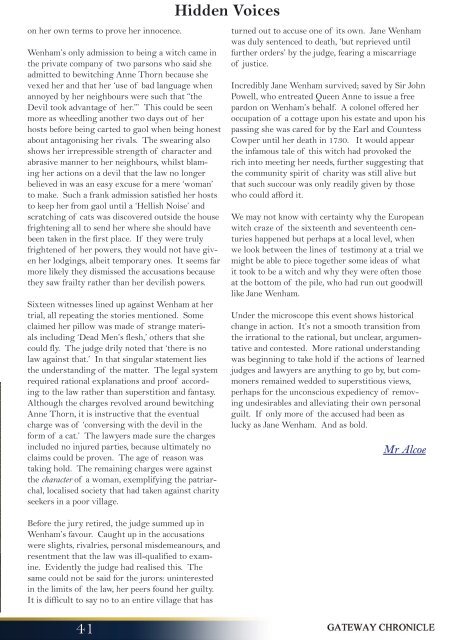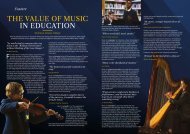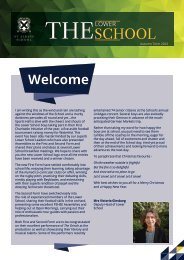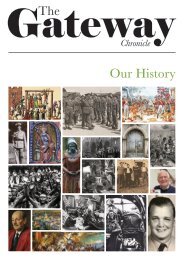You also want an ePaper? Increase the reach of your titles
YUMPU automatically turns print PDFs into web optimized ePapers that Google loves.
41<br />
on her own terms to prove her innocence.<br />
Wenham’s only admission to being a witch came in<br />
the private company of two parsons who said she<br />
admitted to bewitching Anne Thorn because she<br />
vexed her and that her ‘use of bad language when<br />
annoyed by her neighbours were such that “the<br />
Devil took advantage of her.”’ This could be seen<br />
more as wheedling another two days out of her<br />
hosts before being carted to gaol when being honest<br />
about antagonising her rivals. The swearing also<br />
shows her irrepressible strength of character and<br />
abrasive manner to her neighbours, whilst blaming<br />
her actions on a devil that the law no longer<br />
believed in was an easy excuse for a mere ‘woman’<br />
to make. Such a frank admission satisfied her hosts<br />
to keep her from gaol until a ‘Hellish Noise’ and<br />
scratching of cats was discovered outside the house<br />
frightening all to send her where she should have<br />
been taken in the first place. If they were truly<br />
frightened of her powers, they would not have given<br />
her lodgings, albeit temporary ones. It seems far<br />
more likely they dismissed the accusations because<br />
they saw frailty rather than her devilish powers.<br />
Sixteen witnesses lined up against Wenham at her<br />
trial, all repeating the stories mentioned. Some<br />
claimed her pillow was made of strange materials<br />
including ‘Dead Men’s flesh,’ others that she<br />
could fly. The judge drily noted that ‘there is no<br />
law against that.’ In that singular statement lies<br />
the understanding of the matter. The legal system<br />
required rational explanations and proof according<br />
to the law rather than superstition and fantasy.<br />
Although the charges revolved around bewitching<br />
Anne Thorn, it is instructive that the eventual<br />
charge was of ‘conversing with the devil in the<br />
form of a cat.’ The lawyers made sure the charges<br />
included no injured parties, because ultimately no<br />
claims could be proven. The age of reason was<br />
taking hold. The remaining charges were against<br />
the character of a woman, exemplifying the patriarchal,<br />
localised society that had taken against charity<br />
seekers in a poor village.<br />
Before the jury retired, the judge summed up in<br />
Wenham’s favour. Caught up in the accusations<br />
were slights, rivalries, personal misdemeanours, and<br />
resentment that the law was ill-qualified to examine.<br />
Evidently the judge had realised this. The<br />
same could not be said for the jurors: uninterested<br />
in the limits of the law, her peers found her guilty.<br />
It is difficult to say no to an entire village that has<br />
Hidden Voices<br />
turned out to accuse one of its own. Jane Wenham<br />
was duly sentenced to death, ‘but reprieved until<br />
further orders’ by the judge, fearing a miscarriage<br />
of justice.<br />
Incredibly Jane Wenham survived; saved by Sir John<br />
Powell, who entreated Queen Anne to issue a free<br />
pardon on Wenham’s behalf. A colonel offered her<br />
occupation of a cottage upon his estate and upon his<br />
passing she was cared for by the Earl and Countess<br />
Cowper until her death in 1730. It would appear<br />
the infamous tale of this witch had provoked the<br />
rich into meeting her needs, further suggesting that<br />
the community spirit of charity was still alive but<br />
that such succour was only readily given by those<br />
who could afford it.<br />
We may not know with certainty why the European<br />
witch craze of the sixteenth and seventeenth centuries<br />
happened but perhaps at a local level, when<br />
we look between the lines of testimony at a trial we<br />
might be able to piece together some ideas of what<br />
it took to be a witch and why they were often those<br />
at the bottom of the pile, who had run out goodwill<br />
like Jane Wenham.<br />
Under the microscope this event shows historical<br />
change in action. It’s not a smooth transition from<br />
the irrational to the rational, but unclear, argumentative<br />
and contested. More rational understanding<br />
was beginning to take hold if the actions of learned<br />
judges and lawyers are anything to go by, but commoners<br />
remained wedded to superstitious views,<br />
perhaps for the unconscious expediency of removing<br />
undesirables and alleviating their own personal<br />
guilt. If only more of the accused had been as<br />
lucky as Jane Wenham. And as bold.<br />
Mr Alcoe


















